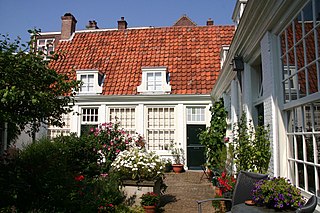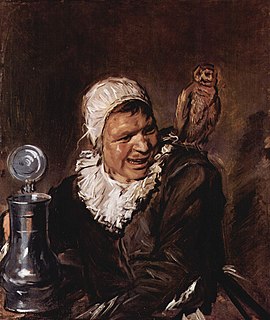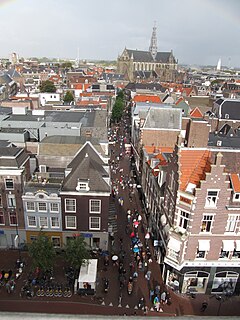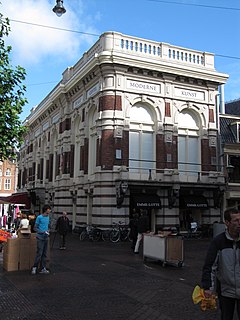
Trou Moet Blycken is a historical chamber of rhetoric over 500 years old and currently a gentlemen's club located in the middle of a busy shopping area on the Grote Houtstraat in Haarlem, Netherlands.

Trou Moet Blycken is a historical chamber of rhetoric over 500 years old and currently a gentlemen's club located in the middle of a busy shopping area on the Grote Houtstraat in Haarlem, Netherlands.

Though the society probably goes back earlier in time, the earliest document from the archives shows that it definitely was mentioned by name in 1503, so this has been historically used as the year of establishment, most recently for the 500 year anniversary in 2003. [1] This was not the only chamber of rhetoric in Haarlem; The Haarlem painters Job Adriaenszoon Berckheyde and Salomon de Bray were members of the chamber called 'De Wijngaardranken'. The club has kept most of its rich archive and paraphernalia and often collaborates with local institutions such as the Frans Hals Museum, the Historisch Museum Haarlem and the Noord-Hollands Archief to display some of their rich cultural artifacts of theater life in Haarlem and of the broader low countries of the 17th-century. Most notable is the lottery and rhetoric contest that the club hosted in 1609 which involved several chambers of rhetoric who brought their "blazoen" (blason) with them as a gift, and these are still on display in the meeting hall. The club leaders commissioned a written version of the various acts held at the 1609 international contest that was written by Zacharias Heyns and published in 1607. [2]
The front of the building is decorated with pelicans, symbolizing the blazoen of the chamber itself, a pelican feeding its young. [3]

Frans Hals the Elder was a Dutch Golden Age painter, normally of portraits, who lived and worked in Haarlem.

The Frans Hals Museum is a museum located in Haarlem, the Netherlands.

The City Hall in Haarlem is the seat of the city's government. It was built in the 14th century replacing the Count's castle.

Hofje van Guurtje de Waal is a hofje in Haarlem, Netherlands.

Frans Hals Museum - Hal is one of the two locations of the Frans Hals Museum, located on the Grote Markt, Haarlem, Netherlands, where modern and contemporary art is on display in alternating presentations. The emphasis is on contemporary photograph and video presentations, with the focus on Man and society.

Chambers of rhetoric were dramatic societies in the Low Countries. Their members were called Rederijkers, from the French word 'rhétoricien', and during the 15th and 16th centuries were mainly interested in dramas and lyrics. These societies were closely connected with local civic leaders and their public plays were a form of early public relations for the city.
Flemish literature is literature from Flanders, historically a region comprising parts of present-day Belgium, France and the Netherlands. Until the early 19th century, this literature was regarded as an integral part of Dutch literature. After Belgium became independent from the Netherlands in 1830, the term Flemish literature acquired a narrower meaning and refers to the Dutch-language literature produced in Belgium. It remains a part of Dutch-language literature.

Judith Jans Leyster was a Dutch Golden Age painter. She painted genre works, portraits and still lifes. Although her work was highly regarded by her contemporaries, Leyster and her work became almost forgotten after her death. Her entire oeuvre was attributed to Frans Hals or to her husband, Jan Miense Molenaer, until 1893. It wasn't until the late 19th century that she was recognized for her artistic abilities.

Pieter Langendijk was a damask weaver, city artist, dramatist, and poet.

Malle Babbe is a painting by the Dutch Golden Age painter Frans Hals, painted between 1633 and 1635 and now in the Gemäldegalerie, Berlin. The painting has also been titled as Hille Bobbe or the Witch of Haarlem. It was traditionally interpreted as a tronie, or genre painting in a portrait format, depicting a mythic witch-figure. The painting is now often identified as a genre-style portrait of a specific individual from Haarlem, known as Malle Babbe, who may have been an alcoholic or suffered from a mental illness.

Frans Pietersz de Grebber was a Dutch Golden Age painter.

Jan Nagel was a Dutch Renaissance painter.

The Grote Houtstraat is a shopping street in Haarlem that connects the Grote Markt to the Houtplein in the direction of the Haarlemmerhout woods.

The Verweyhal is an exhibition space next to the Vleeshal on the Grote Markt, Haarlem. The Verweyhal was built in the 19th century as a gentlemen’s society of the former drama society, later a cultural social club, Trou moet Blycken.

St. Mark is a painting by the Dutch Golden Age painter Frans Hals, painted in 1625. It was purchased from the art dealer Colnaghi, London in September 2013 for the Pushkin Museum and donated to that museum in November that year, where it still hangs.

Zacharias Heyns was a Netherlands printer and engraver from the Northern Netherlands.

Self-portrait by Judith Leyster is an Dutch Golden Age painting in oils in the collection of the National Gallery of Art that was offered in 1633 as a masterpiece to the Haarlem Guild of St. Luke. It was attributed for centuries to Frans Hals and was only properly attributed to Judith Leyster upon acquisition by the museum in 1949. The style is indeed comparable to that of Hals, Haarlem's most famous portraitist.
The following is a timeline of the history of the municipality of Haarlem, Netherlands.

Portrait of Stephan Geraedts, Husband of Isabella Coymans is an oil on canvas painting by Antwerp-born Dutch Golden Age painter Frans Hals. The painting was originally part of a couple of pendant wedding portraits. Hals probably painted the present portrait, Stephanus Geraerdts', alderman in Haarlem, and the accompanying portrait of the latter's wife Isabella Coymans around 1650-1652, six or seven years after their marriage in 1644. Isabella's portrait is now in a private collection in Paris.
| Dutch Rijksmonument 19211 |
![]() Media related to Trou Moet Blycken at Wikimedia Commons
Media related to Trou Moet Blycken at Wikimedia Commons